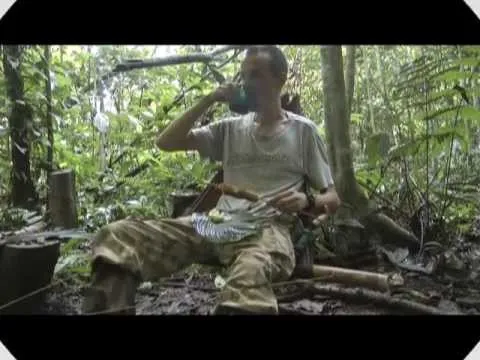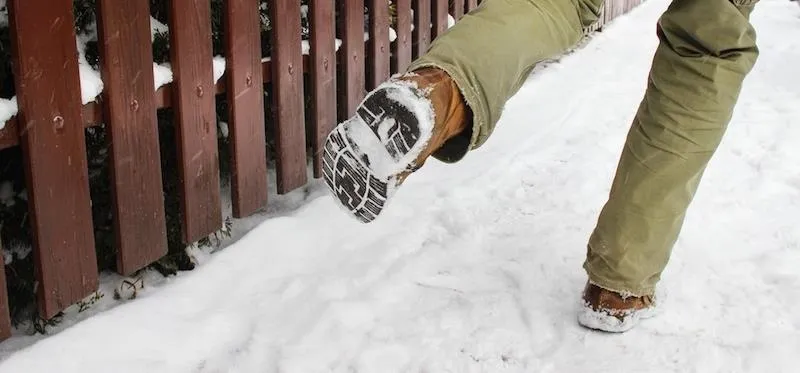There's a good chance that you'll be alone in life one day, and no... I'm not talking about a couch-bound, dateless loser with a pocket pussy and a bag of potato chips. I'm talking about alone. In the wilderness. Hungry. Cold. Lost. You can't stay in one place too long, so it would be nice to have something to carry your belongings in. Maybe it's post-apocalyptic land where you're the sole survivor, and all the backpacks and rucksacks in the world are but mere ash. Either way, knowing this simple survival skill for building an emergency rucksack would prove to be very helpful, if needed.
Someone else that should know how to create a makeshift ruck is a soldier, especially one at wartime. Surviving the wilds of Iraq or Afghanistan alone may not be the first thing on a soldier's mind when they enter the war zone. If you're a soldier headed for a tour of duty there, you'd think it's impossible to be by your lonesome in the vasts of the desert sands. But it happens, believe me, and the best thing you can do is be prepared.
Your survival may not depend upon your knowledge of fashioning makeshift rucksacks out of junk, but it might just help you along your way to finding your way back. I know if I was stuck in the middle of the desert by myself, and I didn't have an assault bag or rucksack with me, I'd want to make one. It's the easiest way to carry things on the go.

In wartime, the only thing you should be keeping in your pockets is ammunition. If you're a photographer, maybe it's a camera. If you're a journalist, perhaps it's a notepad or a digital recorder. If you're a civilian, you'd probably have your cell phone. Whoever you are, the best way to keep maneuverable from the enemy is to make a ruck and keep everything besides your ammo in it— spare water, weapons cleaning kit, extra clothes, food, etc.
There are plenty of rucksack-making techniques out there, but I would always stay with the simplest solution and avoid the elaborate ones, especially in the Middle East where you should be spending your time trying to find your way back to base or to a safe zone where people can help you. So, below is a configuration to keep in mind for rucksack construction in the desert.

Possible Ruck Materials
There is a limitless supply of items you can use to make a quick and easy rucksack in the wild. You can use anything from wood, bamboo, rope, clothing, animal skins, plants, canvas and many other materials. In Iraq, there is usually an excess of trash and junk that you could use, like metal rods, rope, tarps or plastic bags. If you're in the middle of the desert with nothing around you, you might have a hard time making a pack without using the items on your body.
The Horseshoe Pack
The horseshoe pack is the easiest ruck to make in a survival situation. It's pretty comfortable if you find the right materials for straps and it's a quick solution. This is the only ruck you should be making stranded alone in a hostile environment, because any other one will waste your time.
Gather the Material
There are a few things you will need to construct this backpack, like a flat square-like object for the pack and rope or similar object for the straps.
Main Bag
An Army soldier is bound to have a poncho or poncho liner on him at some point. If you're lucky enough to have one on you while stranded, it serves the perfect solution for the main bag. More than likely though, you don't have this on you. It's not a priority to carry something like this, unless you can jam it inside your assault bag, but if you have an assault bag, you would have no reason to make a ruck, now would you?
Other materials for the main bag can be found around you, like an old canvas sheet or similar tarp. Anything will do really… an old dirty blanket in the sand, a large plastic bag floating away in the wind, or even a sheep's skin, if you would be so daring (though this probably won't be worth your time or effort). As a last resort, you can even use your BDU, DCU, or ACU jacket (or other top) as the pack material, but that leaves you with the possibility of getting burnt by the sun. Not only can you get burnt in the Middle East without wearing your uniform jacket, but you'll also get dehydrated quicker. The long sleeves keep you cool throughout peak times, so I would only suggest using your top during nighttime treks or when in shady areas.
Strap and Ties
For the strap and ties, it's as simple as finding a ropelike material to use. It's always good to carry a few strands of 550 cord (also known as paracord or parachute cord) on you when deployed. It always seems to save the day, in one way or another. So, 550 cord is the best option for military personnel. If you don't have any, look around for any rope, cord, or wire. Wire won't be very comfortable, but you can always cushion it later. Also, you can roll up plastic bags (if your packing list isn't too heavy) or use plant fibers for straps.
Lay Out the Main Bag
This is where it gets easy. The first thing you'll do to make this horseshoe ruck is lay out the main bag you have obtained flat on the ground.

Pack Your Belongings
Whatever you plan to carry in your rucksack, lay all of the items down on one edge of the material. Depending on the size of your squared-material, you may have to limit your contents, keeping food and water priority. Make sure to leave room on the ends for tying later in step 5.

Roll It Up
Take the edge of the material near the items and roll it overtop them, then continue rolling to the opposite edge of the material.

Rolling

Rolled

Rolling

Rolled
Tie It Together
To keep your packed items from falling out, tie some of the ropelike material you found securely around both ends of the pack. Take a few extra strands and add extra ties along the length of the bundle, to keep the ruck from falling apart.

Tie the ends

And tie the middle

Tie the ends

And tie the middle
Strap It
Take your cord in a long strand, long enough to go across your chest and to the ends of your bundle. You can adjust this if necessary. Tie each end of the ropelike material to the ends of the pack and it's ready to wear. Just throw the cord over your chest and rest the cord on one shoulder.

There are different methods for making emergency rucksacks, but almost all of them require more time and effort, which you can't afford to waste in enemy territory, like the square pack that requires an excess of limbs or sticks, along with a good amount of cordage. I would just stick with the simple pack, especially in a war zone. If you want to check out a more detailed way to make a rucksack, check out the video below with survivalist expert Ray Mears (more suited toward a wooded environment).

























Comments
Be the first, drop a comment!